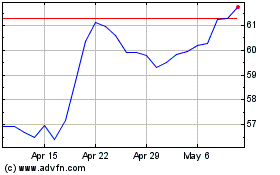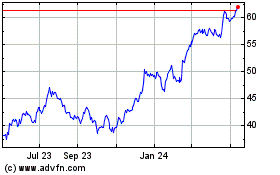By Ben Eisen
A long list of challenges confronted Wells Fargo & Co. Chief
Executive Charles Scharf when he was brought in to restore the
bank's tarnished reputation. In the year since, his problems have
only multiplied.
America's fourth-largest bank is in the grip of a recession that
threatens to deliver steep loan losses. Near-zero interest rates
are straining profit margins. And the bank is still in hot water
with regulators, which imposed a growth cap as a result of the
bank's four-year-old fake-account scandal and the plethora of
problems it exposed.
Then there are the self-inflicted wounds. Mr. Scharf has drawn
fire from employees and Washington lawmakers for filling top jobs
with a largely white, largely male cadre of former colleagues --
and for saying there were few Black candidates with the required
experience for those positions. The episode damaged morale within
the bank, especially among Black staffers, current and former
employees said.
Mr. Scharf had little room for error when he came to Wells Fargo
last October from Bank of New York Mellon Corp., pledging to clean
up a mess that started in its branches and spread to nearly every
one of its businesses. Two CEOs had already resigned after failing
to convince Washington regulators and lawmakers that the bank was
on the mend.
As he heads into his second year on the job, Mr. Scharf finds
himself in a position familiar to his predecessors: playing
defense.
Mr. Scharf is "focused on resolving important regulatory issues
created by past misconduct, putting the right leadership team in
place, and building an organizational foundation for Wells Fargo's
future success," a spokeswoman said in a statement. "He and his
team did this while also dealing with the negative impacts of the
COVID-19 pandemic and providing support for our customers and
communities."
When he became CEO, Mr. Scharf, a one-time protégé of JPMorgan
Chase & Co. CEO James Dimon, acknowledged the mistakes of the
past and swiftly attempted to remake the bank's insular culture.
"We need to be more direct with each other," he said at his first
employee town hall last fall.
He encouraged decisiveness. He mandated more rigorous
performance reviews. In some corners of the bank, people call him
"Chainsaw Charlie, " according to people inside the bank.
Mr. Scharf's defenders said he is laying the groundwork for the
company's rebound. Much of the progress, they said, is happening
behind the scenes -- in the vast web of systems and technology that
is meant to catch problems like the 2016 sales scandal.
He had some early wins. In February, the bank reached a $3
billion settlement to end civil and criminal investigations tied to
the sales scandal that had dogged the bank for years. He testified
before the House Financial Services Committee the following month
and -- unlike his predecessors -- emerged largely unscathed. He
raised minimum hourly pay in most of the bank's U.S. markets.
But 2020 has tested Mr. Scharf in unexpected ways.
The coronavirus recession threw Wells Fargo for a loop. The
bank, whose revenue has been falling for a few years, reported its
first loss since 2008 in the second quarter and slashed its
dividend. The bank, like its peers, has set aside billions of
dollars to cover bad loans. Its stock has lost more than half of
its value since the beginning of 2020. Analysts polled by FactSet
expect the bank to post a modest profit when it reports
third-quarter results next week, but still lower than a year
earlier.
Mr. Scharf has imposed steep cost cuts to help the bank weather
the downturn. Layoffs, expected to ultimately number in the tens of
thousands, have set employees on edge. Job cuts often happen on
Tuesdays, according to people familiar with the matter, and a new
policy instituted during Mr. Scharf's tenure requires laid-off
employees to leave immediately, instead of in 30 days.
Regulatory constraints, meanwhile, have complicated Mr. Scharf's
ability to steer the bank through the crisis.
When corporate customers rushed to draw down on their credit
lines in the pandemic's early days, Wells Fargo bumped up against
an asset cap imposed by the Federal Reserve as punishment for the
fake-account scandal.
The bank lobbied the Fed to lift the cap, arguing it was
constraining its ability to lend. The regulator granted the bank a
narrow and temporary reprieve so it could make loans under the
government's small-business rescue program, but it has declined to
lift the cap altogether.
Most recently, Mr. Scharf was criticized for comments he made
about the lack of Black talent at the most senior levels of
finance.
Mr. Scharf has brought in new leadership consisting largely of
white men he previously worked with in other finance jobs,
including at JPMorgan. The bank, meanwhile, has lost some of its
highest-ranking Black female employees, the Charlotte Observer
recently reported.
As of last year, Wells Fargo's executives and senior managers
were 87% white and less than 3% Black, according to company data.
In recent months, Mr. Scharf has hired three senior Black
executives, two of whom serve on the bank's powerful operating
committee.
In a June memo committing to diversify the company and its
senior ranks, he asked that employees withhold judgment until after
he had two years on the job to make progress.
"The unfortunate reality is that there is a very limited pool of
Black talent to recruit from with this specific experience," he
said, referring to the expertise needed to manage Wells Fargo's
regulatory issues.
Many workers were upset by his comments at the time,
particularly Black employees who were rising through the ranks.
When the comments resurfaced in a Reuters story in September, Mr.
Scharf was widely criticized. Staffers said they felt uncomfortable
having to defend the bank to people outside it.
The company initially tweeted this response from Mr. Scharf: "I
am sorry my comment has been misinterpreted." Later, in a letter to
employees, he wrote: "I apologize for making an insensitive comment
reflecting my own unconscious bias. There are many talented diverse
individuals working at Wells Fargo and throughout the financial
services industry and I never meant to imply otherwise."
On a Sept. 25 call arranged for a Black employee group, he took
a moment to acknowledge some of the many "well-written" letters he
had received from people around the bank in response to his
comments, according to people familiar with the call. That further
angered some employees, who likened it to when Black people are
praised for being articulate.
A Wells Fargo spokeswoman said: "While some may have heard
Charlie's comments differently, his intention was to convey that he
was moved by the thoughtful perspectives and insights that he had
received."
On the call, he also offered more context around his June
comments.
"If you look at the full paragraph and the full intent, there
was still plenty wrong with it, but I certainly didn't mean it the
way it's being portrayed more broadly," he said, according to a
recording reviewed by The Wall Street Journal. "Having said that, I
do understand it, and I think it is important that we use it as an
opportunity, and I've used it as an opportunity, to react to all
the things we've heard."
Write to Ben Eisen at ben.eisen@wsj.com
(END) Dow Jones Newswires
October 08, 2020 05:44 ET (09:44 GMT)
Copyright (c) 2020 Dow Jones & Company, Inc.
Wells Fargo (NYSE:WFC)
Historical Stock Chart
From Mar 2024 to Apr 2024

Wells Fargo (NYSE:WFC)
Historical Stock Chart
From Apr 2023 to Apr 2024
